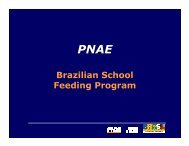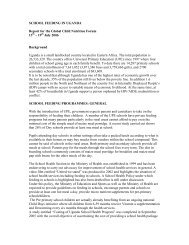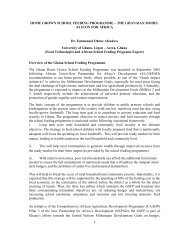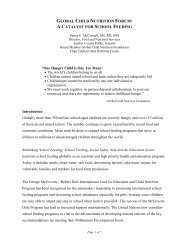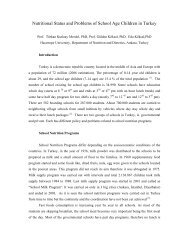EXECUTIVE SUMMARY - Global Child Nutrition Foundation
EXECUTIVE SUMMARY - Global Child Nutrition Foundation
EXECUTIVE SUMMARY - Global Child Nutrition Foundation
You also want an ePaper? Increase the reach of your titles
YUMPU automatically turns print PDFs into web optimized ePapers that Google loves.
independent assessors are now used to monitor financial<br />
accounting and the entire process of resource flows.<br />
These measures have greatly improved school feeding program<br />
accountability. They are leading to enhanced community<br />
ownership and greater community contributions to the program,<br />
in cash and in-kind.<br />
Tanzania<br />
The daily implementation of Tanzania’s school meals<br />
program depends on community participation.<br />
The school feeding program in Tanzania is currently WFPfunded,<br />
but the WFP in conjunction with the national government<br />
is working to equip local authorities to take over program<br />
implementation and management. Local community members<br />
have been sensitized about the issues of school feeding and<br />
trained to do jobs such as prepare meals and eating places,<br />
procure food and safeguard the food against theft. The WFP<br />
conducts regular meetings with community members to ensure<br />
that efforts do not lapse.<br />
Tanzania’s school meals program operates in five regions,<br />
benefitting 700,000 schoolchildren. Maize, beans and cooking oil<br />
are provided. <strong>Child</strong>ren receive porridge and lunch daily<br />
throughout the year. The program has made significant progress<br />
toward its education-focused objectives: raising enrollment and<br />
attendance rates, improving academic performance and<br />
stabilizing the dropout rate.<br />
Tanzania’s government is in the very initial stages of taking the<br />
program national. What form a national school feeding program<br />
might take is still undecided.<br />
Ethiopia<br />
School feeding programs are locally run according to<br />
national guidelines.<br />
In Ethiopia, the school meals program is run by local<br />
communities according to national guidelines, published in<br />
multiple languages and widely distributed. These guidelines<br />
define the responsibilities and procedures for financial and<br />
program management to be followed by schools.<br />
Committees organized at the school level manage the logistics of<br />
food distribution and select the children who will benefit based on<br />
need (not all children receive the meals).<br />
However, determining family income levels is difficult and most<br />
parents petition the committee to have their children fed. This<br />
situation is challenging for the local committees. Transporting<br />
food represents another big challenge.<br />
Scaling Up Sustainability: Linking School Feeding with Agriculture<br />
Development to Maximize Food Security<br />
May 3-7, 2011<br />
Nairobi, Kenya<br />
© 2011 GCNF and PCD. All rights reserved. Page 31<br />
Uganda<br />
School feeding benefits children in the neediest regions.<br />
School feeding programs have operated in Uganda since 1965.<br />
They are administered differently in different regions depending<br />
on the poverty levels of the population. Parents sometimes pay<br />
fees for school meals.<br />
All schools in the troubled Karamoja region are provided with<br />
grains, salt and vegetable oil. Teachers are trained and<br />
community members mobilized to use these resources for school<br />
meals. Community members have built 38 teachers’ huts in a<br />
work for cash program. While paying cash has drawbacks, it is<br />
viewed as a good way to involve parents.<br />
Uganda has a home grown school feeding program in the pilot<br />
stage. Community members produce commodities for schools<br />
and hospitals. Parents are provided with seed and are expected<br />
to send food to school with children and to contribute to the<br />
program in cash or in-kind.<br />
The Ugandan government maintains that the responsibility for<br />
feeding children rests squarely with parents. A participant asked<br />
how the government reconciles that stance with the large<br />
numbers of Ugandan children orphaned by AIDS. A government<br />
representative responded that orphans, if identified as such and<br />
registered, do benefit from various food aid programs.<br />
Cameroon<br />
Cameroon is working on a national school feeding strategy<br />
to sustain and expand upon WFP efforts.<br />
The school meals program in Cameroon dates from 1998. It is<br />
administered by the WFP in three of the nation’s 10 provinces.<br />
Some 246 schools are assisted, benefiting 58,000 children. The<br />
impacts have been positive and the government of Cameroon<br />
hopes to establish within the Education Department a national<br />
school feeding program by year-end. The WFP will be ending its<br />
support in 2012.<br />
Parent participation had been weak in the rural, food-insecure<br />
areas where the program operates. But involvement is growing<br />
with efforts to sensitize the communities. Some parents<br />
supplement WFP efforts by contributing fish and vegetables.<br />
Parents organize food preparation efforts, rotating the job of<br />
cooking. If the designated cook is not available, however, no food<br />
is served.<br />
The national school feeding program strategy that the government<br />
is working on will address such problems. It will have<br />
clearly defined objectives, coordination of activities, monitoring<br />
mechanisms and training efforts. A pilot program now underway<br />
to continue the WFP program as well as the lessons learned at<br />
GCNF’s 2011 conference will help Cameroon create a strategy<br />
that prioritizes school feeding at the national level.



